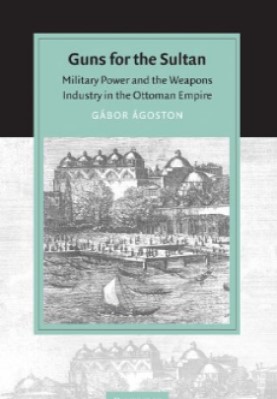Guns for the Sultan: Military Power and the Weapons Industry in the Ottoman Empire

| Guns For The Sultan |
| Gábor Ágoston |
| 284 |
| |
| PDF Direct Download Link |
| Click for Hard Copy from Amazon |
GUNS FOR THE SULTAN – Book Sample
The “discovery” of gunpowder, the appearance of firearms, and especially their mass employment in warfare was one of the most significant developments of the late Middle Ages. Gunpowder – a mixture of saltpeter, sulfur and charcoal -was first made in China in the seventh or eighth century AD and the first proper firearms were manufactured there from the 1280s onward.
The first firearm “had three basic features: its barrel was of metal; the gunpowder used in it was rather high in nitrate; and the projectile totally occluded the muzzle so that the powder charge could exert its full propellant effect.”‘ Within decades, gunpowder weapons had reached both Islamdom and Christian Europe, and by the first decades of the fourteenth century firearms were being used in European battlefields and sieges. By mid-century, firearms had reached Hungary and the Balkans, and by the 1380s the Ottomans were also acquainted with the new weapon.
The Ottoman conquest of Constantinople was but one dramatic illustration of how, by the 1450s, cannons had become a decisive weapon in siege warfare. In the early fifteenth century, cannons were frequently being used aboard European ships and towards the end of that century shipboard artillery had already proved its value on the Mediterranean war galleys.^
The appearance of firearms and their mass employment in battles, sieges and by navies significantly changed the way states and empires waged wars. In order to remain militarily competitive in the gunpowder age, states needed cannons, cannon-proof fortifications, a sizable infantry armed with handguns, as well as navies with shipboard artillery. Organized violence between states and empires….
Gunpowder technology, the Military Revolution thesis and the Ottomans
As can be seen from the two quotations that open this book, contemporary politi- cians, Europeans and Ottomans alike, were well aware of the significance of firearms. The spread of gunpowder weapons stirred passionate debate among intel- lectuals of the Renaissance.^
Although no comparable debate in the contemporane- ous Ottoman literature is detectable, it is noteworthy that the seventeenth-century Ottoman historian Ibrahim Pe9evi included a small section about the manufactur- ing of black powder in his chronicle. Writing around 1640, Pe9evi repeated the well-known European myth about Berthold Schwarz, perhaps following one of his Hungarian sources.
What is more interesting, though, is the fact that Pe9evi discussed the invention of “black powder” together with that of printing.® Many European historians have considered the “discovery” of gunpowder and that of printing as the two most significant inventions of the late Middle Ages. Indeed, historians, especially in Europe, have long been fascinated with the “gun- powder epic.”
Many of them argued that “gunpowder blasted the feudal strongholds and the ideas of their owners,” a notion that was shared by such authorities as David Hume (1711-76) and Adam Smith (1723-90). Johan Huizinga went even further when he wrote that “the rebirth of the human spirit dates from the discovery of firearms.”‘®
According to one of the most influential historical theses of the late twentieth century – Geoffrey Parker’s Military Revolution theory – gunpowder weapons had far-reaching consequences regarding state formation and the power balance between states and civilizations. Parker substantially modified Michael Roberts’s original conception of the Military Revolution. In Parker’s version of the thesis, gunpowder weaponry and military technology occupy center stage.
Since only monarchs possessed the necessary financial and organizational means to invest in cannon-proof fortresses {trace italienne) and to establish and main- tain artillery corps of sufficient size to besiege these fortifications successfully,
To read more about the Guns For The Sultan book Click the download button below to get it for free
Report broken link
Support this Website
 Don't Miss out any Book Click Join OpenMaktaba Telegram group
Don't Miss out any Book Click Join OpenMaktaba Telegram group